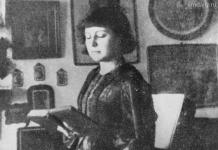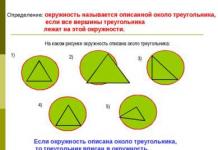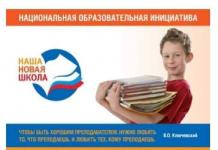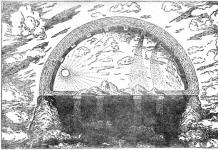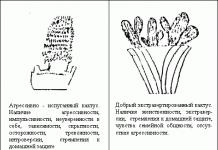Based on the tasks being solved, the following are distinguished: types of lessons: 1) Introductory lessons are carried out before the start of a new independent section programs. They provide a solution common tasks educational process, clarification of methodological or organizational issues. They are characterized by the widespread use of verbal and visual methods, low “motor” density; 2) Basic lessons depending on the predominant focus of one of the parties to the process physical education may focus on teaching motor actions or developing motor abilities. In the first case, they are designated as lessons of study, repetition or consolidation educational material, in the second - as lessons in the development or maintenance of motor abilities. Lessons on consolidating and improving educational material; 3) Control (accounting, test) lessons are intended to determine the level of preparedness of students, check their assimilation of knowledge, skills, and abilities, to measure various morphofunctional indicators, and state of fitness. 4) Mixed (complex) lessons combine tasks characteristic of the above types of lessons. They are aimed at jointly solving the problems of teaching movement techniques, developing physical qualities, monitoring the level of physical fitness of students, etc. This type of lessons is most widely used in physical education practice. One of the indicators of the effectiveness of a lesson is its density. There are general (pedagogical) and motor (motor) density of the lesson. The total density is the ratio of pedagogically justified time spent to the duration of the lesson and is determined by the formula: total density = (to: ty) x 100%, where to is the pedagogically justified time, except for downtime, ty is the duration of the entire lesson. The total density should be 100%.
Motor (motor) density It is generally accepted to consider the ratio of the time used directly for any motor activity of those engaged during a lesson to its total duration and is calculated by the formula: motor density = (tр: ty) x 100%, where tр – execution time physical exercise, ty – duration of the entire lesson.
Before you draw a conclusion: good or bad motor density of the lesson, you need to know what problem was solved in the lesson. If you teach a technique..., then 50% is considered a good indicator, and if you improve a technique..., then 50% is considered an unimportant indicator, and 70-80% is considered good. Dependence of motor density: on age, gender, physical degree preparedness of students, from the material and technical base of the school, from the number of students in the class, from the preparation of the teacher for the lesson, from the task being solved in the lesson, from the type of lesson, from the method of organizing students in the lesson. In order to assess the time spent and simultaneously determine the general and motor density of the lesson, the activities of the students are observed and timed. The so-called average student, quite active and disciplined, is selected as the subject of observation. Timing data is processed after the end of the lesson. After receiving the data on the general and motor density of the lesson, it is necessary to analyze them in accordance with the tasks assigned to the lessons, the characteristics of the students and the conditions of the lesson. The assessment should be accompanied by your recommendations on the means and ways of increasing the general and motor density of this lesson.
On lessons physical culture To control the intensity of physical exercise depending on the gender, age and preparedness of students during the lesson, heart rate (HR) is used, which is a direct indicator of the load.
The advantages of the heart rate intensity indicator include:
a) the comparative simplicity of measuring heart rate in athletes, which does not require instruments and devices;
b) sufficient information about internal changes in the student’s body in the process of performing a physical exercise;
c) the impossibility of selecting and using other load indicators, since physical education lessons use means of different structures - dynamic, static, situational exercises.
"Physiological curve" It is customary to call the change in heart rate during physical exercises throughout the lesson. In this regard, when analyzing the physical exercises used, the average heart rate per lesson and the nature of its change in all parts of the lesson are distinguished by intensity: introductory, main and final.
The average heart rate during a lesson depends to a certain extent on the type and type of lesson. In gymnastics lessons using standard equipment, the average heart rate is significantly lower than in athletics, skiing or sports lessons. Depending on the type of lessons, heart rate is low in introductory lessons and control lessons and reaches 110-120 beats/min, high in improvement and training lessons (160-170 beats/min). Intermediate heart rate values (150 beats/min) are observed during combined physical education lessons. It must be emphasized that one of the requirements for the selection of physical exercises in terms of intensity in a lesson is the average heart rate within the range of no less than 130 and no more than 170 beats/min, i.e. the work is in the moderate power zone. In the introductory part of the lesson, which lasts 12-15 minutes, the heart rate increases and can reach 170-180 beats/min, i.e. the average heart rate in this part of the lesson is within 160 beats/min. In the main part, depending on the tasks, the heart rate decreases by 10-20 beats/min, but at the end of the lesson the heart rate should not exceed the initial level by more than 20 beats/min. Thus, in a physical education lesson, the “physiological curve” distinguishes two peaks in the rise in heart rate - in the introductory part of the lesson and at the end of the main part of the lesson during the development of motor quality. During the main part of the lesson, the “physiological curve” has a plateau, i.e. steady state, with slight fluctuations in heart rate during exercise and rest. The “physiological curve” allows you to evaluate the correctness of the selection of physical exercises depending on the level of preparedness of students and the distribution of the intensity of physical exercises across parts of the lesson.
The student scheduled for observation must be warned in advance, informing him of the purpose, content and procedure of the upcoming procedure. The heart rate is calculated before performing exercises or a series of exercises and immediately after performing them. To do this, the timekeeper must approach the student in a timely manner so as not to distract him and avoid a pause after the work has been completed, and it is advisable to make all measurements when the students are in the same free main stance.
After the end of the lesson, the obtained ten-second heart rate indicators are converted into minute ones, according to which the graphic image heart rate dynamics during the lesson - its “curve”.
When analyzing the data obtained, the type of lesson and the content planned in the notes are taken into account. The actual load curve is evaluated based on overall health deployment requirements.
By the height of the “curve,” one can conditionally judge the intensity of the load, and by the size of the area of the “curve” and projections from the initial pulse, one can judge its volume. The entries in the notes provide answers to questions that arise.
In order for the analysis of the obtained data to be sufficiently convincing, it is necessary to study special literature on the functional characteristics of the cardiac activity of students of the appropriate age.
Analysis of the data obtained and a graphical representation of the dynamics of heart rate indicators indicate a significant volume and intensity of the load in the lesson.
Basics of ensuring safety in physical education lessons at school. Techniques and methods of insurance. Medical, psychological and pedagogical techniques providing first aid in case of injury.
The problem of compliance with safety precautions in physical education lessons is undoubtedly one of the important places in the system of organizing the educational process of schoolchildren. Following generally accepted norms and standards, a physical education teacher must always clearly know the safety instructions. General requirements safety precautions related directly to the physical education teacher include the following required components: Physical education teachers in their practical activities in physical education must be guided by safety instructions, state acts and documents on labor protection developed by the Ministry of Education of the Russian Federation, and monitor students’ compliance with rules and instructions on labor protection. A physical education teacher or other person conducting a physical education and sports lesson is responsible for the safety of the life and health of students. A physical education teacher must: take courses (at least once every 5 years) on labor protection; take part in testing gymnastic apparatus and equipment; make proposals to improve the conditions for conducting educational process; organize the study by students of rules on labor protection at home, etc. A physical education teacher must know: the readiness and functional capabilities of each student; the medical group to which students are assigned based on the results of a medical examination; students released by a doctor from physical exercise after illness, and mark students absent from class. Observe the principles of accessibility, consistency in teaching students and compliance of the given exercises and loads curriculum; carry out warm-up and increase the time allotted for it in strong winds, low temperatures and high humidity; Reduce the load or increase rest time when students show signs of fatigue; provide insurance when students perform complex technical elements; Monitor students' compliance with instructions, rules of behavior in physical education lessons and make decisions on removing students from participation in educational process for gross violation; Organize students to clean sports equipment and equipment in their storage areas; To remove students from the place of the lesson in an orderly manner; Carry out a thorough inspection of the location of the lesson, turn off the lights, lock all utility rooms and the gym; Bring to the attention of the person responsible for the gym and sports ground a message about all shortcomings in ensuring the educational process; If you complain of illness or poor health, immediately refer the student to a doctor; Promptly notify management of every accident. In the event of a fire in the gym, open emergency exits and take students out in an orderly manner according to the evacuation plan to a safe place, report the fire to the fire department and begin to eliminate the source of the fire.
28. Requirements for rational nutrition of athletes. Composition of food products. The concept of a balanced diet. Energy consumption in various types sports. First aid for food poisoning Rational or adequate nutrition (lat. r nationalis- reasonable, meaningful) - this is physiologically complete nutrition healthy people, which corresponds to the energy, plastic, biochemical needs of the body. This type of nutrition ensures the constancy of the internal environment of the body, supports the functional activity of organs and systems, as well as their resistance to the effects of adverse environmental factors. In the literature, in addition to the term “rational nutrition”, one can find its synonyms - “correct”, “scientifically based”, “optimal”, “balanced”, “adequate nutrition”. All these terms are equivalent in content. A balanced diet is, first of all, nutrients or so-called nutrients. Fats and carbohydrates are needed as a source of energy to support processes occurring in the body. Proteins, minerals and water are needed as for everyone - avoid excess fatty, floury, fried foods and try to always include in a balanced diet menu foods rich in proteins, fiber, complex carbohydrates, as well as fresh fruits and vegetables. The protein requirement for intensively training athletes is 1.5-2.0 grams per kilogram of body weight per day. Protein intake of more than 3 g/kg is not recommended even for athletes in sports such as weightlifting, throwing and gymnastics, since the body is usually unable to cope with the breakdown and absorption of such a mass of protein. However, insufficient protein intake (less than 1.5 g per kg of body weight) also does not contribute to the normalization of metabolic processes, since this may lead to an increase in the excretion from the body of such important vitamins as vitamin C, thiamine, riboflavin, pyridoxine, niacin, as well as potassium salts. building material cells and tissues to maintain the balance of the internal environment of the body. Vitamins and microelements are necessary for a balanced metabolism in the body. It is necessary to follow a diet, it is necessary to adhere to a balanced diet menu that is suitable for age, health and energy needs. Golden Rulex substances. However, the body of a professional athlete experiences an increased need for these nutrients, so athletes are recommended to additionally take specialized multivitamin-mineral complexes and biologically active food supplements. Vitamins are substances vital for the body that are not formed in the body (or are formed in limited quantities), but come from food. The daily need for certain vitamins is small and measured in milligrams. Typically, vitamins serve multiple functions in the body. One of them is the so-called coenzyme function. Many vitamins are part of enzymes - biological catalysts, without which no life can occur. important reaction in organism. These vitamins include most water-soluble vitamins, in particular vitamins PP, group B and others. Minerals account for 4-5% of the body's weight. They are found in all tissues of the body, but their highest content is in bone tissue, to which they provide hardness and high strength. Mineral compounds are part of substances that perform structural functions and substances that regulate metabolic processes, ensure the flow of nervous processes, osmotic phenomena that cause the movement of water in tissues, and much more. The metabolism of minerals is closely related to the metabolism of water, which necessarily increases in connection with sports training. Especially a lot of water, and with it minerals, leaves the body with sweat. Excessive sweating during training and competitive games is a sure sign of an increased need for mineral compounds. The need for sodium compounds, phosphoric acid salts and calcium compounds, as well as potassium compounds, iron and many others increases by at least 1.5-2 times.
Reason food poisoning In most cases, bacterial contamination of products occurs during their preparation, storage, and transportation. They are caused by microorganisms such as salmonella, staphylococcus, coli and botulism bacillus. Food poisoning is mainly accompanied by nausea, vomiting, diarrhea, pain in the stomach and intestines. The disease lasts 2-5 days, then, in almost all cases, self-healing occurs. A food poisoning victim is advised to rest, drink plenty of fluids, rest in bed and fast. Consumption of food usually causes a deterioration in general condition.
There are general (pedagogical) and motor (motor) density of the lesson.
The total density of a lesson is the ratio of pedagogically justified (rational) time spent to the total duration of the lesson.I
The overall density of the lesson includes the following pedagogically appropriate activities:
1) organization of students, verification homework, setting educational objectives;
learning and consolidation of theoretical information;
3) conducting general developmental exercises;
4) instruction, regulation, correction (error correction), assistance, insurance;
5) preparation and cleaning of equipment, necessary movements of students during the lesson, etc.;
6) studying the technique of physical exercises, developing physical qualities;
7) methodological training students, developing the ability to study independently, as well as organizational skills;
8) motivation of students;
9) use visual aids, technical means, demonstration of exercises;
10) pedagogical control;
11) summing up, doing relaxation exercises, setting homework;
12) educational work at the lesson.
To determine the overall density (OD) of a lesson or its parts, the indicators of active activity time in the lesson are summed up. This includes time spent doing exercise, listening, observing and organizing the lesson, excluding time spent waiting unnecessarily and being idle. This time is multiplied by 100% and divided by the total lesson time: AAAAAAAAAAAAAAAAAAAAAAAA
OP = tad * 100% / ttot
The total density of a full-fledged physical education lesson should approach 100%. The following reasons lead to a decrease in the overall lesson density:
Unjustified downtime during the lesson (late start, untimely preparation of class areas and equipment, waiting in line before performing exercises);
Lack of preparation of the teacher for the lesson; ill-conceived organization and content of the lesson, leading to pauses;
Excessive and ineffective verbal information for students in the lesson;
Unsatisfactory discipline of students, which leads to irrational use of time due to repeated repetition of commands and orders, comments to students, repetitions of explanations, etc.
For example, if downtime in a lesson due to the fault of the teacher was 1 minute, then the total density of the lesson will be equal to:
OP = 39 min * 100% / 40 min = 97.5%
The motor density of a lesson is the ratio of the time spent directly on the motor activity of students to the total duration of the lesson.
To calculate motor density (MD), it is necessary to multiply the time of physical exercise tfu by 100% and divide by the total time of the lesson, ttot:
MP = tfu * 100% / ttotal
For example, it was found that the total time spent by students on physical exercises is 25 minutes. In this case, the motor density of the lesson will be equal to:
MP = 25 min * 100% / 40 min = 62.5%
Motor density is constantly changing during the lesson. The inevitability of such changes can be explained primarily by the difference in the content of the exercises used, the place of their use and the methods of application. Indicators of motor density also change depending on the type of lesson. Thus, in lessons on improving movement techniques and developing physical qualities, it can reach 70-80%, and in lessons on learning motor actions and developing knowledge, which require significant time spent on the mental activity of students, motor density can be at the level of 50%.
Despite the importance of the motor density of the lesson, it cannot reach 100%, since otherwise there would be no time left for explaining the material, understanding it by students, analyzing errors, which would inevitably lead to a decrease in quality and efficiency academic work generally.
A lesson is the main form of organizing physical exercises.
Compared to other forms of physical education, a physical education lesson has a number of advantages, since it:
a) is the most widespread form of organized, systematic and compulsory classes for schoolchildren;
b) is carried out on the basis of a scientifically based state program designed for long periods of study;
c) carried out under the guidance of a teacher, taking into account age, gender and individual characteristics schoolchildren;
d) promotes the comprehensive and harmonious physical improvement of all students, regardless of their motor abilities, sports results, distribution into medical groups, etc.
Physical education lessons in secondary school are held 2 times a week for 40-45 minutes each. Their main content is motor activity.
Requirements for the lesson.
1. Clarity in setting goals and objectives.
2. Compliance of the composition of the educational material with the curriculum and the nature of the tasks.
3. Expedient selection of teaching tools and methods, taking into account the didactic purpose and objectives of the lesson.
4. Close connection of lessons with previous and subsequent ones.
5. A combination of frontal, group and individual work.
6. Constant modification of the content of the lesson, methods of its organization and delivery.
7. Ensuring lesson safety.
8. Constant monitoring of progress and results educational activities students.
Educational objectives
Wellness tasks
Educational tasks
Classification of lessons depending on the tasks to be solved.
Based on the predominant focus on solving educational, health or educational tasks There are four types of lessons.
1. Combined lessons. All three groups of physical education tasks are represented in them approximately equally.
2. Lessons with a predominantly health-improving focus are conducted in two versions: the first is developmental (formative) lessons that serve the development of various body systems, the second is restorative (rehabilitation) lessons aimed at restoring strength and performance.
3. Lessons with a predominantly educational focus are differentiated depending on the specific objectives of moral or aesthetic education.
4. Lessons with a predominantly educational focus are divided into five types:
Introductory lessons are held at the beginning school year, quarter, when studying a new section of the curriculum.
Lessons on learning new material (educational). Their main tasks are to familiarize students with new motor actions and their initial mastery.
Improvement lessons apply to in-depth study and consolidation of educational material.
Mixed (complex) lessons contain tasks and elements characteristic of the types of lessons listed above.
Test lessons are aimed at determining the level of preparedness of students, checking their acquisition of knowledge, skills and abilities on a topic or section of the program.
Overall Density 79.5% is insufficient and is explained by the untimely start of the lesson and the teacher’s insufficient ability to interest students in the proposed exercises, as well as ineffective organization of the exercises in the main part of the lesson.motor primarily actions (performing physical exercises, moving and installing equipment, distributing and collecting teaching aids, preparing training sites, mutual assistance, etc.);
rest- expedient and inappropriate expenditure of time is taken into account and assessed.
When conducting a lesson, there may be cases when the time spent cannot be called rational, pedagogically justified (the class is late for the start of the lesson, the end of the lesson before the bell rings, protracted preparation of class places, searching for equipment, etc.) and in this case, the time spent is defined as “ simple"and are not included in the density percentage.
The following reasons lead to a decrease in the overall lesson density:
§ unnecessary downtime in class(lateness, untimely preparation of training places and equipment, etc.);
§ teacher's lack of preparation for the lesson, ill-conceived content and organization of the lesson, leading to inevitable loss of time;
§ excessive and ineffective verbal information for students in class;
§ irrational use of time due to unsatisfactory discipline engaged, repeated repetitions of explanations, commands and orders from the teacher, comments to students.
Physical activity is largely determined by the dosage of physical exercise, i.e., the number of exercises, their repetition, the time allocated to perform the exercises, as well as the conditions for their implementation.
All physical exercises have an impact on the body of those involved - some more, others less strongly. A lesson consisting of a large number of exercises also provides great physical activity. Consequently, the workload in lessons can be different, and the teacher is obliged to regulate it. Students should not be overloaded. This can cause fatigue and affect their performance. At the same time, you should not limit yourself to a very light load, since then the effect of physical exercise on the body will be insufficient.
MOTOR DENSITY OF PHYSICAL EDUCATION LESSON
Motor density of the lesson – this is the ratio of the time used directly for the motor activity of students to the total duration of the lesson.
To calculate motor density (MD), it is necessary to multiply the time spent performing physical exercises by 100% and divide by the total time of the lesson.
Motor density is constantly changing during the lesson. The inevitability of such changes can be explained, first of all, by the difference in the content of the actions used, techniques, exercises, place of their use and methods of application. Indicators of motor density also change depending on the type of activity.
Despite the importance of the motor density of the lesson, it cannot reach 100%, since otherwise there would be no time left to explain the material, to comprehend it by the students, to analyze errors, which would inevitably lead to a decrease in the quality and effectiveness of educational activities as a whole.
Depending on the type and motor orientation of the lesson, motor density indicators can change and reach high level, especially in high school. Thus, motor density in sports lessons will be higher than motor density in gymnastics lessons.
|
|
eliminating the noted shortcomings and identifying ways to increase the density of the lesson.
Timing of a physical education lesson.
Lesson objectives:
I. Educational:
1. Improve the execution of a somersault tuck:
a) crouching forward point-blank (girls);
b) back from the gray (boys).
2.Improve landing in a vault with legs apart.
II. Educational:
1. Develop coordination, strength, speed-strength abilities.
III. Educational:
Foster a sense of organization and discipline.
Class: 5 "A"
There are 28 people in the class list. 24 were present (15 boys, 9 girls).
Observation was carried out on the student
Timed the lesson:
An approximate recording of lesson density analysis.
The beginning of the lesson was not clearly organized. The class was 2 minutes late, which explains the downtime in the preparatory part of the lesson
When conducting general developmental exercises, the teacher first explained and showed the exercises, and then the students performed them. It would be more appropriate to conduct them by name or by the command “Do it once,” etc. This would reduce the time spent on demonstration and explanation, especially since the exercises are well known to schoolchildren. The total duration of the preparatory part is 19. 00 min.” tightened.
In the main part of the lesson, when performing exercises, the student performed the vault 5 times, and the somersault only 3 times and spent 1 minute 26 seconds on this, and 8 minutes 31 seconds waiting in line and resting. The time to wait in line and rest when performing difficult coordination exercises (jumping over a “goat”) should be no more than 2 minutes. In this case, there was unjustified downtime. Increasing the number of repetitions will not only increase the motor density of the lesson, but will also be more consistent with the task of improving the learned movements. It was possible to increase motor density by introducing an additional exercise in the intervals between the main tasks (an element of circuit training). For example, in jumping, this could be bouncing in place on two legs and then assuming a correct landing position.
They were forced to take various forced pauses, most of them inappropriate. Continuing the main part of the lesson, the student being observed completed 2 sets of long jump (one out of order) and 4 sets of throwing. The motor density of the main part of the lesson could be increased by using a throwing exercise in pairs.
The teacher spent more than two minutes making comments about discipline. Taking into account the characteristics of this class (the children are quite disciplined and studied with interest), it can be assumed that more thorough preparation by the teacher for the lesson, specification of particular tasks, and selection of appropriate methodological methods of teaching, education, and organization will contribute to improving discipline.
There was virtually no pedagogically significant final part of the lesson: the guys hastily put away the shells, lined up, and with that the lesson was over. The teacher did not have time to summarize, evaluate and motivate students for the next classes. Including due to ineffective use of time in the previous stages.
The general and motor density of the lesson could have been increased; there were reserves for this.
Offers:
1. Attention should be paid to better development of the outline and timely organization of material and technical conditions.
Timekeeper's signature:____________________
Lesson rating: _________________
Signature of the lesson teacher:________________
Summing up the timing of the lesson, it should be remembered that the sum of all rational and unproductive time spent (columns 4) should be equal to the total duration of the lesson
Table 1. Approximate indicators of motor density in lessons of various types
METHODOLOGY FOR CARRYING OUT THE TIMELINE OF A PHYSICAL LESSON
One of the indicators of the effectiveness of a lesson is its density. It is necessary to determine the density of the lesson as a whole and in parts. This is due to unequal opportunities and conditions for organizing work in the preparatory, main and final parts of the lesson. The total time spent on the lesson (or part of it) is taken as 100%. Percentage values are calculated relative to it.
Density- this is the ratio of rationally used time to the total time allocated for the lesson. The less time is lost in the lesson, the higher the density of the lesson.
There are general (pedagogical) and motor (motor) density of the lesson.
Total lesson density- this is the ratio of pedagogically justified (rational) time spent to the total duration of the lesson.
The overall density of the lesson includes the following pedagogically appropriate activities:
1) organizing students, checking homework, setting educational tasks;
2) communication and consolidation of theoretical information;
3) conducting general developmental exercises;
4) instruction, regulation, correction (error correction), assistance, insurance;
5) preparation and cleaning of equipment, necessary movements of students during the lesson, etc.;
6) studying the technique of physical exercises, developing physical qualities;
7) methodological training of students, development of the ability to study independently, as well as organizational skills;
8) motivation of students;
9) use of visual aids, technical means, demonstration of exercises;
10) pedagogical control;
11) summing up, doing relaxation exercises, setting homework;
12) educational work in the classroom.
To determine the overall density (OD) of a lesson or its parts, the indicators of active activity time in the lesson are summed up. This includes time spent doing exercise, listening, observing and organizing the lesson, excluding time spent waiting and being idle. This time is multiplied by 100% and divided by the total lesson time.
The total density of a full-fledged physical education lesson should approach 100%.
The following reasons lead to a decrease in the overall lesson density:
Unjustified downtime during the lesson (late start, untimely preparation of class areas and equipment, waiting in line before performing exercises);
Lack of preparation of the teacher for the lesson; ill-conceived organization and content of the lesson, leading to pauses;
Excessive and ineffective verbal information for students in the lesson;
Unsatisfactory discipline of students, which leads to irrational use of time due to repeated repetition of commands and orders, comments to students, repetitions of explanations, etc.
Motor density of the lesson- this is the ratio of the time used directly for the motor activity of students to the total duration of the lesson.
To calculate motor density (MD), it is necessary to multiply the time spent performing physical exercises by 100% and divide by the total time of the lesson.
For example, it was found that the total time spent by students on physical exercises is 25 minutes (the remaining 15 minutes were spent on explanations from the teacher, preparing places for classes, rest intervals between related tasks, etc.). In this case, the motor density of the lesson will be equal to:
P(motor) = (25 x 100) : 40 = 62.5%
Motor density is constantly changing during the lesson. The inevitability of such changes can be explained, first of all, by the difference in the content of the exercises used, the place of their use and methods of application. Indicators of motor density also change depending on the type of lesson.
Thus, in lessons for improving movement techniques and developing physical qualities, it can reach 70-80%, and in lessons for learning motor actions and developing knowledge that require significant time spent on the mental activity of students, motor density can be at the level of 50% .
Despite the importance of the motor density of a lesson, it cannot reach 100%, since otherwise there would be no time left to explain the material, comprehend it by students, and analyze errors, which would inevitably lead to a decrease in the quality and effectiveness of educational work as a whole. .
Methodology for determining the density of a physical education lesson using timing.
Timing is carried out using a stopwatch, by observation. The stopwatch starts with the bell for class. You can work by the hour. If the work is carried out frontally, with the whole class, then we monitor the whole class. If the work is carried out in departments, then we monitor one department, and in it one student, and then continue the work, taking into account the transition to another project.
You can time the lesson following components: O - explanation; P - work; P - loss of time. You can separately time the wait in line at the projectile, rest.
Preparing and cleaning equipment is classified as work (P), if carried out in an organized manner, and if unorganized, it is a loss of time (P); loss of time includes being late for a class for any reason, malfunctioning equipment, or poor discipline.
The timing results are recorded and then displayed graphically. Motor density can be 50-80% depending on the type of lesson, section of the program, age and preparedness of students, their number, teaching method and method of teaching the lesson, the amount of equipment and its condition, etc.
In order to increase the density of the lesson, you can not do a roll call, if possible, not do an explanation with a demonstration of the exercise, introduce additional equipment, use the role of assistants, etc.
Timekeeping ends with the bell from class. When starting to time a lesson, you should prepare a timekeeping protocol in advance in the form:
The data is processed in the form of a graph. Scale 1 minute = 0.5 cm. To draw a graph you need:
1. Measure the horizontal line 45 minutes - 22.5 cm, if 40 minutes - 20 cm;
3. You can spot check individual components on the graph.










